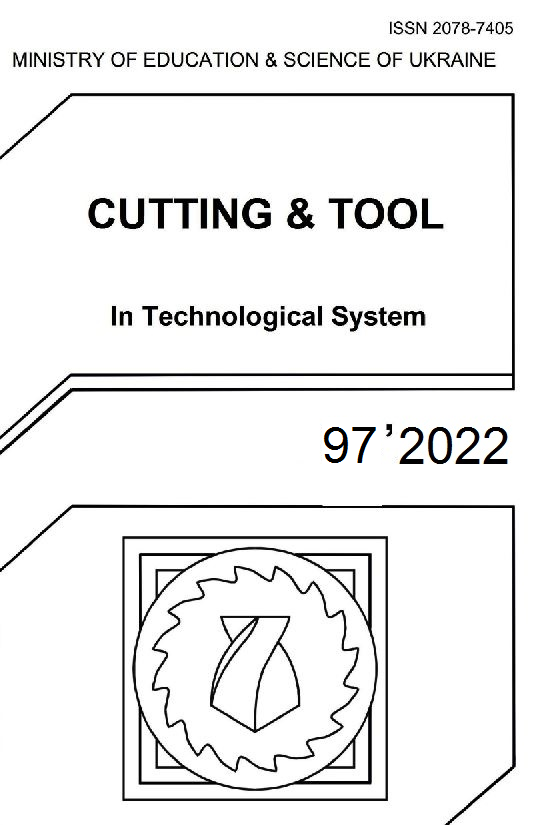ANALYZING THE EFFECT OF THE TOOL PASS NUMBER AND THE DIRECTION OF SLIDING BURNISHING ON SURFACE ROUGHNESS
DOI:
https://doi.org/10.20998/2078-7405.2022.97.06Keywords:
turning, burnishing, surface roughness, environmentally friendly machiningAbstract
Nowadays, the concern of environmental protection is becoming more and more important in production as well. They often contribute to this by reducing or eliminating the amount of coolants and lubricants, or by using alternative machining methods. One of them is burnishing, which makes a positive effect on surface integrity, while reduces the environmental load. In this paper we examined the change in surface roughness achieved by burnishing after turning on a corrosion-resistant steel workpiece, where the number of burnishing passes and burnishing direction were changed. The results showed increased smoothness, bearing capacity and dimensional stability by increasing the number of passes from 1 to 2, however, the 3 times repetition did not show any additional favorable improvement on the surfaces. In case of the forward-backward-forward burnishing directions, further chipping occurred, in other cases the effect of the directions was negligible on the amplitude roughness parameters, but considerable on the parameters characterizing the roughness peak. The greatest improvement was achieved with the backward-forward settings.
References
Kundrák, J., Mamalis, A.G., Gyáni, K., Markopoulos, A.: Environmentally friendly precision machining, Materials and manufacturing processes vol.21(1) (2006) pp.29-37.
Varga, Gy., Szigeti, F., Kovács, A.: Analysis of Surface Roughness of Holes Machined by Environmentally Friendly Way (in Hungarian). Műszaki Tudomány az Észak-kelet Magyarországi Régióban 2012. MTA Debreceni Akadémiai Bizottság, Debrecen, Hungary, 2012, pp. 433-442.
Varga, G., Sovilj, B., Jakubowicz, M., Babič, M.: Experimental Examination of Surface Roughness in Low-Environmental-Load Machining of External Cylindrical Workpieces. International Scientific-Technical Conference MANUFACTURING, Springer, Cham, 2019, pp. 307-321.
Antal, N., Gyula, V.: Effect of abandonment of cooling and lubrication on surface roughness and cylindricity in turning of steel, Multidiszciplináris Tudományok vol.11(4) (2021) pp.395-407.
Kundrák, J., Varga, G., Deszpoth, I.: Analysis of Extent of Environment Load in Alternative Manufacturing Procedures. WSEAS Transactions on Environment and Development vol.14 (2018) pp.313-320.
Sztankovics, I., Kundrak, J.: Theoretical Value and Experimental Study of Arithmetic Mean Deviation in Rotational Turning. Rezanie I Instrumenty V Tekhnologicheskih Sistemah vol.96 (2022) pp.73-81.
Ferencsik, V., Varga, G.: Examination of surface state-change on diamond burnished aluminium components. Proceedings of the International Symposium for Production Research 2019, Springer, Cham, 2020, pp.535-544. 8. Stephenson, D.A., Agapiou, J.S.: Metal cutting theory and practice. CRC press, 2018.
Maheshwari, A.S., Gawande, R.R.: The role of burnishing process in manufacturing industry - A state-of-the-art survey, International Journal of Engineering Research and Development vol.13 (2017) pp.50-60.
Grzesik, W., Zak, K.: Modification of surface finish produced by hard turning using superfinishing and burnishing operations, Journal of Materials Processing Technology vol.212(1) (2012) pp.315-322.
Varga, G., Ferencsik, V.: Analysis of surface topography of diamond burnished aluminium alloy components. Vehicle and Automotive Engineering, Springer, Cham, 2017, pp.143-154.
Ferencsik, V., Varga, G.: The Influence of Diamond Burnishing Process Parameters on Surface Roughness of Low-Alloyed Aluminium Workpieces, Machines vol.10(7) (2022) ArtNo.:564.
Rami, A., Gharbi, F., Sghaier, S., Hamdi, H.: Some insights on combined turning-burnishing (CoTuB) process on workpiece surface integrity, International Journal of Precision Engineering and Manufacturing vol.19(1) (2018) pp.67-78.
Hassan, A.M., Al-Dhifi, S.Z.: Improvement in the Wear Resistance of Brass Components by the Ball Burnishing Process, Journal of Materials Processing Technology vol. 96(1) (1999) pp.73-80.
Hirose, M., Hayasaka, T., Shamoto, E.: Unique regenerative chatter in wiper-turning operation with burnishing process, Part 1: Prediction and analytical investigation of generation mechanism, critical stability, and characteristics, Precision Engineering vol.71 (2021) pp.304-312.
Alshareef, A.J., Marinescu, I.D., Basudan, I.M., Alqahtani, B.M., Tharwan, M.Y.: Ball-burnishing factors affecting residual stress of AISI 8620 steel, The International Journal of Advanced Manufacturing Technology vol.107(3) (2020) pp.1387-1397.
Shi, Y.L., Shen, X.H., Xu, G.F., Xu, C.H., Wang, B.L.,
Su, G.S.: Surface integrity enhancement of austenitic stainless steel treated by ultrasonic burnishing with two burnishing tips, Archives of Civil and Mechanical Engineering vol.20(3) (2020) pp.1-17.
Molnár, V., Sztankovics I.: Analysis of Roughness Parameters Determining Tribological Properties in Hard Turned Surfaces. Hungarian Journal Of Industry And Chemistry vol.49(2) (2021) pp.77-84.
Kovács, Z.F., Viharos, Z.J., Kodácsy, J.: Improvements of surface tribological properties by magnetic assisted ball burnishing, Surface and Coatings Technology vol.437 (2022) ArtNo.:128317.
Downloads
Published
Issue
Section
License
Copyright Notice
Authors who publish with this Collection agree to the following terms:
1. Authors retain copyright and grant the Collection right of first publication with the work simultaneously licensed under a Creative Commons Attribution License that allows others to share the work with an acknowledgement of the work's authorship and initial publication in this Collection.
2. Authors are able to enter into separate, additional contractual arrangements for the non-exclusive distribution of the Collection's published version of the work (e.g., post it to an institutional repository or publish it in a book), with an acknowledgement of its initial publication in this Collection.
3. Authors are permitted and encouraged to post their work online (e.g., in institutional repositories or on their website) prior to and during the submission process, as it can lead to productive exchanges, as well as earlier and greater citation of published work.

